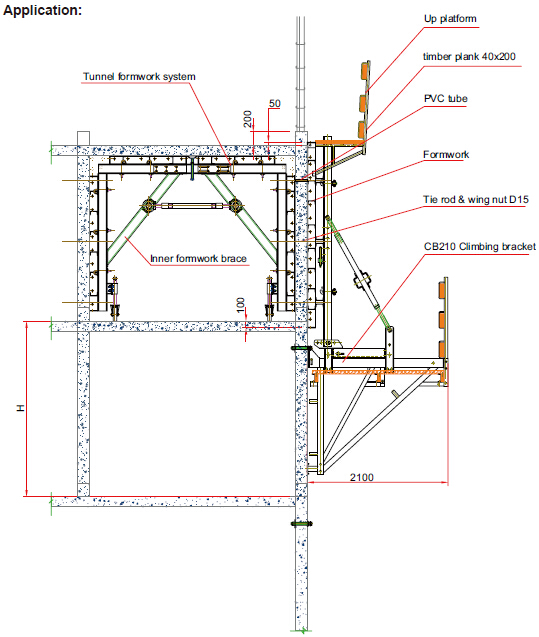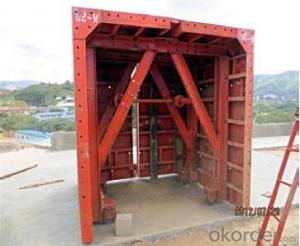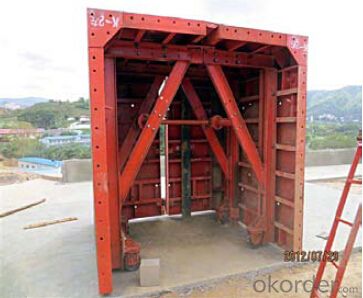Steel tunnel for formwork and scaffolding system
- Loading Port:
- Tianjin
- Payment Terms:
- TT OR LC
- Min Order Qty:
- 50 m²
- Supply Capability:
- 1000 m²/month
OKorder Service Pledge
Quality Product, Order Online Tracking, Timely Delivery
OKorder Financial Service
Credit Rating, Credit Services, Credit Purchasing
You Might Also Like
Building Tunnel Formwork:
A compositional steel formwork system mainly used in the building which has regular structure
without beams, the excellent formwork system can make the integral pouring for the wall & slab
easily achieved.
Characteristics:
◆ High stiffness, make perfect shape for concrete.
◆ Easy operation, save labor and force.
◆ Fast forming, repeatedly turnover.

- Q: Can steel formwork be used for both residential and industrial projects?
- Yes, steel formwork can be used for both residential and industrial projects. It offers durability, strength, and flexibility, making it suitable for various construction applications. Steel formwork is commonly used in both residential and industrial projects for its ability to withstand heavy loads, provide a smooth finish, and ensure accurate dimensions.
- Q: What are the different types of steel alloys used in formwork manufacturing?
- There are several types of steel alloys that are commonly used in formwork manufacturing due to their specific properties and characteristics. These alloys include: 1. Mild Steel: Mild steel, also known as low carbon steel, is a popular choice for formwork manufacturing due to its affordability and versatility. It has a relatively low amount of carbon and is easy to work with, making it suitable for various formwork applications. 2. High-strength Steel: High-strength steel alloys, such as high-strength low-alloy (HSLA) steel, are known for their increased strength and durability. These alloys have higher levels of carbon and other alloying elements, making them ideal for formwork that requires high load-bearing capacity and resistance to deformation. 3. Stainless Steel: Stainless steel is widely used in formwork manufacturing due to its excellent corrosion resistance properties. This alloy contains a minimum of 10.5% chromium, which forms a thin protective layer on its surface, preventing rust and corrosion. Stainless steel is particularly suitable for formwork used in marine or highly corrosive environments. 4. Tool Steel: Tool steel is a type of high-carbon alloy steel that is specifically designed for tool and die applications. It offers excellent hardness, wear resistance, and toughness, making it suitable for formwork manufacturing where a high level of precision and durability is required. 5. Alloy Steel: Alloy steel is a broad category that includes various types of steel alloys with specific properties tailored for different applications. These alloys are made by adding elements such as chromium, nickel, molybdenum, or tungsten to improve their strength, hardness, and corrosion resistance. Alloy steel can be used in formwork manufacturing that requires specific mechanical properties. Overall, the choice of steel alloy for formwork manufacturing depends on the specific requirements of the project, including load-bearing capacity, corrosion resistance, durability, and cost-effectiveness.
- Q: Can steel formwork be used for precast concrete facades with intricate patterns?
- Yes, steel formwork can be used for precast concrete facades with intricate patterns. Steel formwork is highly versatile and can be custom-designed to create complex shapes and patterns, allowing for the creation of intricate facades. Additionally, steel formwork provides excellent strength and durability, making it suitable for handling the weight and pressure of precast concrete.
- Q: What are the considerations when designing steel formwork for architectural sculptures?
- When designing steel formwork for architectural sculptures, several considerations need to be taken into account. Firstly, the formwork should be able to withstand the weight and pressure of the concrete being poured into it, ensuring structural stability. Additionally, the formwork should be designed in a way that allows for easy installation and removal, as well as ensuring proper alignment and support for intricate or unconventional shapes. The material and thickness of the steel should be chosen carefully to withstand any weather conditions or potential corrosion. Moreover, considerations should be made for any required surface finishes, such as textures or patterns, which may require additional design elements or treatments. Lastly, the cost-effectiveness of the formwork design should also be considered, balancing the required strength and durability with the available budget.
- Q: What are the fire resistance properties of steel formwork?
- Steel formwork is known for its excellent fire resistance properties. Steel is a non-combustible material, which means it does not burn or contribute to the spread of fire. It has a high melting point, making it extremely resistant to heat and flames. In the event of a fire, steel formwork will not collapse or lose its structural integrity, providing a safe environment for workers and preventing the spread of fire to other areas. Additionally, steel formwork does not emit toxic fumes or smoke when exposed to high temperatures, unlike other construction materials such as wood or plastic. This is important for the safety of workers and occupants of buildings, as toxic fumes can be harmful and hinder evacuation efforts during a fire emergency. Furthermore, steel formwork has a low thermal conductivity, meaning it does not transfer heat easily. This property helps to contain the heat within the fire area and prevents it from spreading to adjacent areas. It also reduces the risk of structural damage caused by the expansion and contraction of materials due to heat exposure. Overall, the fire resistance properties of steel formwork make it a reliable choice for construction projects, especially in areas where fire safety is a crucial consideration. Its non-combustible nature, high melting point, lack of toxic fumes, and low thermal conductivity contribute to creating a safe and secure environment in the face of potential fire hazards.
- Q: How does steel formwork compare to other types of formwork in terms of durability?
- Steel formwork is known for its exceptional durability compared to other types of formwork. Unlike wooden or plastic formwork, steel formwork is built to withstand heavy loads and repetitive use, making it ideal for projects that require long-term usability. Steel formwork is not affected by weather conditions, moisture, or decay, making it highly resistant to damage and deterioration. It can withstand extreme temperatures, strong winds, and heavy rains without compromising its structural integrity. This durability ensures that steel formwork can be used in various construction projects, including high-rise buildings, bridges, and tunnels, where strength and reliability are crucial. Another advantage of steel formwork is its ability to bear high concrete pressures. The robustness of steel allows it to handle the pressure exerted by wet concrete during the pouring and curing process. This makes steel formwork highly suitable for projects that involve pouring large volumes of concrete, ensuring that the formwork remains intact and can be reused multiple times. Furthermore, steel formwork has a longer lifespan compared to other materials. Due to its durability, it can be used for multiple construction cycles, reducing the need for frequent replacements. This not only saves time and money but also minimizes waste generated during construction. In summary, steel formwork surpasses other types of formwork in terms of durability. Its resistance to weather conditions, high concrete pressures, and long lifespan make it a reliable choice for construction projects that require a strong and long-lasting formwork system.
- Q: Can steel formwork be used in areas with high seismic activities?
- Indeed, areas with high seismic activities can utilize steel formwork. Renowned for its strength and durability, steel proves to be an appropriate construction material in earthquake-prone regions. The resilience of steel formwork against lateral forces and seismic vibrations guarantees the structure's safety and stability. Moreover, steel formwork offers exceptional flexibility, allowing for tailored construction solutions to accommodate diverse shapes and sizes in high seismic areas. Ultimately, steel formwork emerges as a dependable and efficient choice for construction endeavors in regions characterized by high seismic activities.
- Q: How does steel formwork contribute to improved construction site access?
- Steel formwork contributes to improved construction site access in several ways. Firstly, steel formwork is highly durable and reliable, which allows for the creation of robust and stable structures. This means that construction sites can be accessed more easily and safely by workers, as they can confidently navigate the formwork without concerns about its stability or integrity. Secondly, steel formwork is highly versatile and can be customized to fit any project's specific requirements. This flexibility allows for the creation of complex shapes and designs, which can improve access to different areas of the construction site. For example, curved or inclined formwork can be used to create ramps, staircases, or other access points that facilitate movement and navigation around the site. Additionally, steel formwork is known for its high load-bearing capacity, which means that it can support heavy loads and equipment. This is particularly important in construction projects that involve the use of cranes, scaffolding, or other heavy machinery. By providing a sturdy platform, steel formwork ensures that access is maintained even when heavy loads need to be transported across the site. Furthermore, steel formwork is quick and easy to assemble, which can significantly reduce construction time and improve access on site. Its modular design allows for efficient installation and dismantling, meaning that access points can be created or modified as needed in a timely manner. This is particularly beneficial in projects where construction schedules are tight or where the site layout needs to be adapted frequently. In summary, steel formwork contributes to improved construction site access by providing durability and stability, allowing for versatile designs, supporting heavy loads, and enabling quick and easy assembly. These features enhance worker safety, facilitate movement around the site, and help maintain productivity and efficiency in the construction process.
- Q: What are the different safety certifications and standards for steel formwork?
- There are several safety certifications and standards that apply to steel formwork. These certifications and standards ensure that the steel formwork meets specific safety requirements and can be used safely in construction projects. Some of the different safety certifications and standards for steel formwork include: 1. ISO 9001: This certification ensures that the steel formwork manufacturer has implemented a quality management system and meets the necessary quality standards. It focuses on the overall quality and reliability of the product. 2. ISO 3834: This certification ensures that the welding processes used in the production of steel formwork are carried out in accordance with specific quality requirements. It emphasizes the welding quality and ensures that the welds are strong and durable. 3. EN 12812: This European standard provides guidelines for the design and performance of formwork systems, including steel formwork. It covers aspects such as load-bearing capacity, stability, and safety requirements for formwork systems. 4. OSHA: The Occupational Safety and Health Administration sets safety standards for the construction industry in the United States. While there are no specific certifications for steel formwork, compliance with OSHA standards is essential to ensure a safe working environment for construction workers using steel formwork. 5. BS 5975: This British standard provides recommendations for temporary works, including formwork systems. It covers aspects such as design, erection, use, and dismantling of formwork systems, ensuring safety throughout the construction process. 6. ACI 347: This American Concrete Institute standard provides guidelines for the design, construction, and maintenance of concrete structures. It includes recommendations for formwork systems, including steel formwork, to ensure their safety and effectiveness in supporting the concrete during construction. These certifications and standards play a crucial role in ensuring that steel formwork is manufactured and used safely in construction projects. By adhering to these certifications and standards, construction companies can ensure the safety of their workers and the quality of their structures. It is important for construction professionals to be aware of these certifications and standards and ensure compliance with them when using steel formwork.
- Q: How is steel formwork adjusted for different concrete thicknesses?
- Steel formwork is adjusted for different concrete thicknesses by using adjustable steel soldiers or props. These steel soldiers are placed vertically at regular intervals along the formwork, providing support and stability. By adjusting the height of these soldiers, the formwork can be raised or lowered to accommodate different concrete thicknesses. To adjust the formwork, the steel soldiers are typically equipped with threaded ends that can be screwed up or down. This allows the formwork to be easily raised or lowered to the desired height. The threaded ends of the soldiers are securely fixed into designated holes or slots on the formwork, ensuring stability and preventing any movement during the pouring and curing of concrete. Additionally, steel formwork systems often include adjustable formwork clamps or brackets. These clamps or brackets are used to secure the formwork panels together, ensuring they remain in the desired position and shape. By adjusting the positions and angles of these clamps or brackets, the formwork can be modified to accommodate variations in concrete thickness. Overall, the adjustable nature of steel formwork, through the use of steel soldiers, props, clamps, and brackets, allows for easy customization and adaptation to different concrete thicknesses. This flexibility ensures that the formwork can effectively contain and shape the concrete during the construction process, resulting in high-quality and structurally sound concrete structures.
Send your message to us
Steel tunnel for formwork and scaffolding system
- Loading Port:
- Tianjin
- Payment Terms:
- TT OR LC
- Min Order Qty:
- 50 m²
- Supply Capability:
- 1000 m²/month
OKorder Service Pledge
Quality Product, Order Online Tracking, Timely Delivery
OKorder Financial Service
Credit Rating, Credit Services, Credit Purchasing
Similar products
Hot products
Hot Searches
Related keywords



















